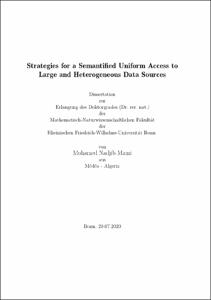Strategies for a Semantified Uniform Access to Large and Heterogeneous Data Sources

Strategies for a Semantified Uniform Access to Large and Heterogeneous Data Sources

| dc.contributor.advisor | Auer, Sören | |
| dc.contributor.author | Mami, Mohamed Nadjib | |
| dc.date.accessioned | 2021-02-18T10:49:48Z | |
| dc.date.available | 2021-02-18T10:49:48Z | |
| dc.date.issued | 18.02.2021 | |
| dc.identifier.uri | https://hdl.handle.net/20.500.11811/8925 | |
| dc.description.abstract | The remarkable advances achieved in both research and development of Data Management as well as the prevalence of high-speed Internet and technology in the last few decades have caused unprecedented data avalanche. Large volumes of data manifested in a multitude of types and formats are being generated and becoming the new norm. In this context, it is crucial to both leverage existing approaches and propose novel ones to overcome this data size and complexity, and thus facilitate data exploitation. In this thesis, we investigate two major approaches to addressing this challenge: Physical Data Integration and Logical Data Integration. The specific problem tackled is to enable querying large and heterogeneous data sources in an ad hoc manner.
In the Physical Data Integration, data is physically and wholly transformed into a canonical unique format, which can then be directly and uniformly queried. In the Logical Data Integration, data remains in its original format and form and a middleware is posed above the data allowing to map various schemata elements to a high-level unifying formal model. The latter enables the querying of the underlying original data in an ad hoc and uniform way, a framework which we call Semantic Data Lake, SDL. Both approaches have their advantages and disadvantages. For example, in the former, a significant effort and cost are devoted to pre-processing and transforming the data to the unified canonical format. In the latter, the cost is shifted to the query processing phases, e.g., query analysis, relevant source detection and results reconciliation. In this thesis we investigate both directions and study their strengths and weaknesses. For each direction, we propose a set of approaches and demonstrate their feasibility via a proposed implementation. In both directions, we appeal to Semantic Web technologies, which provide a set of time-proven techniques and standards that are dedicated to Data Integration. In the Physical Integration, we suggest an end-to-end blueprint for the semantification of large and heterogeneous data sources, i.e., physically transforming the data to the Semantic Web data standard RDF (Resource Description Framework). A unified data representation, storage and query interface over the data are suggested. In the Logical Integration, we provide a description of the SDL architecture, which allows querying data sources right on their original form and format without requiring a prior transformation and centralization. For a number of reasons that we detail, we put more emphasis on the virtual approach. We present the effort behind an extensible implementation of the SDL, called Squerall, which leverages state-of-the-art Semantic and Big Data technologies, e.g., RML (RDF Mapping Language) mappings, FnO (Function Ontology) ontology, and Apache Spark. A series of evaluation is conducted to evaluate the implementation along with various metrics and input data scales. In particular, we describe an industrial real-world use case using our SDL implementation. In a preparation phase, we conduct a survey for the Query Translation methods in order to back some of our design choices. | en |
| dc.language.iso | eng | |
| dc.rights | In Copyright | |
| dc.rights.uri | http://rightsstatements.org/vocab/InC/1.0/ | |
| dc.subject | Semantische Informationsintegration | |
| dc.subject | Datenheterogenität | |
| dc.subject | Semantic Web | |
| dc.subject | SPARQL | |
| dc.subject | Ontologie | |
| dc.subject | Datenbank | |
| dc.subject | Big Data | |
| dc.subject | NoSQL | |
| dc.subject | Semantic Data Integration | |
| dc.subject | Knowledge Graph | |
| dc.subject | Data Heterogeneity | |
| dc.subject | Databases | |
| dc.subject | Semantic Data Lake | |
| dc.subject | Data Lake | |
| dc.subject.ddc | 004 Informatik | |
| dc.title | Strategies for a Semantified Uniform Access to Large and Heterogeneous Data Sources | |
| dc.type | Dissertation oder Habilitation | |
| dc.publisher.name | Universitäts- und Landesbibliothek Bonn | |
| dc.publisher.location | Bonn | |
| dc.rights.accessRights | openAccess | |
| dc.identifier.urn | https://nbn-resolving.org/urn:nbn:de:hbz:5-61180 | |
| ulbbn.pubtype | Erstveröffentlichung | |
| ulbbnediss.affiliation.name | Rheinische Friedrich-Wilhelms-Universität Bonn | |
| ulbbnediss.affiliation.location | Bonn | |
| ulbbnediss.thesis.level | Dissertation | |
| ulbbnediss.dissID | 6118 | |
| ulbbnediss.date.accepted | 28.01.2021 | |
| ulbbnediss.institute | Mathematisch-Naturwissenschaftliche Fakultät : Fachgruppe Informatik / Institut für Informatik | |
| ulbbnediss.fakultaet | Mathematisch-Naturwissenschaftliche Fakultät | |
| dc.contributor.coReferee | Lehmann, Jens |
Dateien zu dieser Ressource
Das Dokument erscheint in:
-
E-Dissertationen (4405)




